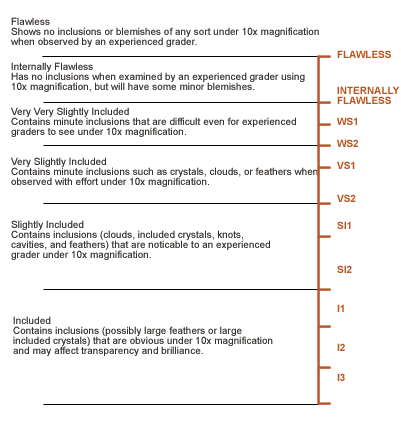RAPLAB® GRADING CRITERIA
The 4 C’s are part of a well-known grading system for evaluating diamonds by grading the carat weight, color, clarity and cut. RAPLAB® grades diamonds based on the 4 C’s and several additional criteria using sophisticated technology to provide you with a more detailed and informative certification.
CLARITY
The Clarity grade labels the diamond for the presence and severity of flaws. No diamond is 100% perfect. With enough magnification you can find a flaw in the cleanest stone.
Diamonds are created in the subterranean pressure of the Lithosphere. Under these extreme conditions, some alien elements like air bubbles may become trapped in the diamond. Other flaws can originate while cutting and polishing the stone.
Diamonds are graded on a scale of eleven levels from F – Flawless to I – some inclusions visible to the naked eye. The gemologist will grade the stone considering the size and proportion of the flaw within the stone. How many flaws are there? How visible are they? More than one inclusion or many reflections will lower the grade.

Clarity is graded under 10 times magnification. At RAPLAB® looking and evaluating the stone with a 10x loupe, our gemologists also examine the diamonds under a gem-microscope to locate spots they missed. After examining with a microscope they check the stone again with 10x magnification in order to decide if these findings need to be mention as inclusions.

FL – Flawless. No internal or external imperfections under x10.
IF – Internally Flawless. No internal imperfections under 10x. Might have some insignificant exterior blemishes which can be removed by slim polish work.

VVS – Very Very Slight Included. The flaw is so little it is really hard to locate even under 10x magnifier.
VVS1 – The Inclusion can be located from side facets or culet just but it is not visible from table up.
VVS2 – Very Very Slight Included

VS – Very Slight Included. Contain minor inclusions that range from difficult to somewhat easy to see under 10x magnification. Typical VS inclusions are small crystals, feathers or distinct clouds. In some rare cases, a VS stone can contain an eye visible inclusion.
VS1 – Very Slight Included
VS2 – Very Slight Included

SI – Slight Included. The flaws are easily spotted with 10x magnification. After finding a flaw you might catch it with your naked eye without magnification.
SI1 – Slight Included
SI2 – Slight Included
SI3 – Slight Included (some gem lab call SI3 a high I1 or SI2-).

I – Included. The flaw is visible to the naked eye without magnification.
I1 – Single flaw. Hard to see but have some reflections so it Interfere the transparency
I2 – Some flaws interfering with the transparency and glossiness over about half of the stone
I3 – Many flaws over most of the stone interfering with the transparency and glossiness until the stone is seen as “dead”
